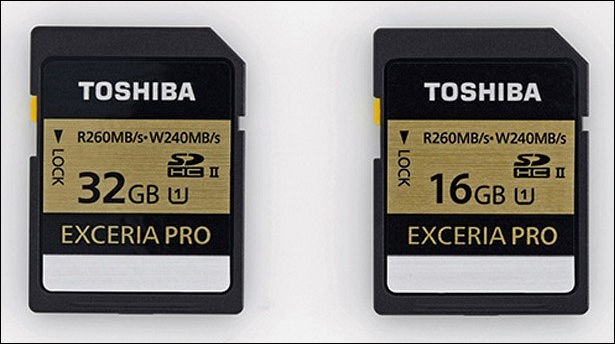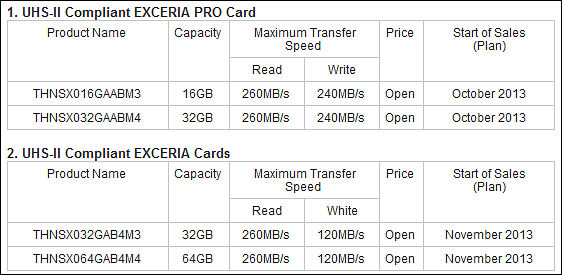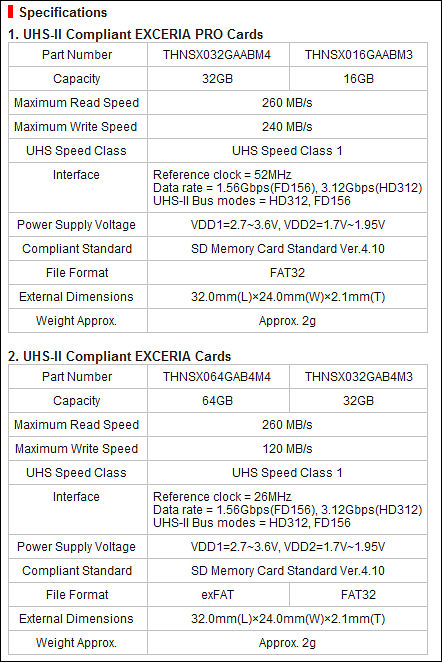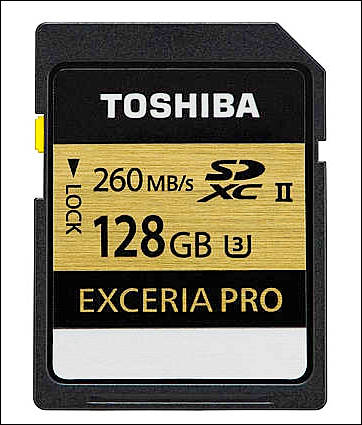
-

TOKYO—Toshiba Corporation (TOKYO: 6502) today announced that it will launch a new series of SD memory cards offering the world's fastest data write speed. The latest edition to its line-up of EXCERIA memory cards designed to offer users of high-end digital cameras an excellent experience, the EXCERIA PROTM1 and EXCERIATM1 cards will be launched in major markets worldwide, starting with Japan in October.
EXCERIA cards compliant with UHS-II will be available in two series. The EXCERIA PRO series will offer photographers a data write speed of 240MB/sec2 the world's fastest3, while the EXCERIA series will write at 120MB/sec. They will allow digital camera users to shoot still images continuously at high speed.
The cards are the first in the EXCERIA line-up to integrate a newly developed controller compliant with UHS-II4 the ultra high speed serial bus interface defined in SD Memory Card Standard Ver. 4.10, and they achieve significantly higher data transfer speeds than earlier UHS-I compliant cards5.
While digital cameras have made huge strides in image quality and versatility, users have long wanted to see improvements in data transfer rates and write times, so as to be able to takes bursts of photographs in quick succession. This demand has grown increasingly strong as high performance digital single-lens reflex cameras and mirrorless interchangeable-lens cameras have gained popularity and moved into the mainstream. Further advances in higher resolution image recording (including 4K2K video), will also fuel demand for transfers of data-rich images at high speed.
Looking to the future, Toshiba, a world leader in the NAND flash memory business, will continue to meet market demands by enhancing its line-up of UHS-II compliant SD memory cards.


Via: http://www.toshiba.co.jp/about/press/2013_07/pr1601.htm
-
Maybe the BMPCC, but that probably only has a UHS-I controller. Regardless, cameras with UHS-II conrtollers will be out soon no doubt.
-
Maybe the BMPCC, but that probably only has a UHS-I controller. Regardless, cameras with UHS-II conrtollers will be out soon no doubt.
In fact, it is very bad news for BM, very bad.
-
What's bad about this?
UHS-II cards are backwards compatible with UHS-I hosts. These new high speed cards should work in the BMPCC, assuming the cards support high write speeds over the UHS-I interface. The BMPCC will do raw over UHS-I.
UHS-II could prove useful in a future camera with higher resolution or a higher frame rate.
UHS-II isn't just a different type of controller. It's a new physical and electrical interface with more contacts. https://www.sdcard.org/developers/overview/bus_speed/


-
You got me wrong.
All I mean is that niche BM is using now is very fragile and high speed SD cards paired with suitable interface in mass cameras can make it just tiny.
-
But I think that they will still have some room to manoeuvre.
It is just pure business logic. Of course they can make some adjustments and new models, but as niche will become very small it'll be very hard to make.
-
I suspect that in near future nothing will really threaten BMPCC at same price point, unless the usual suspects suddenly dare to put pro features into enthusiast cams and eat into their own pro divisions' business
Putting raw in consumer cameras no way will eat into pro business much. As main sales of pro business now is ENG cameras and pro cinema cameras.
-
I will be checking akihabara this month to see if they have any early or pre official release batches selling for cheap(ish). It happens sometimes here (fingers crossed).
-
Another update

PR
Toshiba Announces Availability of New EXCERIA PROTM SD Memory Cards for 4K Video Applications
New UHS-II cards provide UHS Speed Class 3 (U3) support in a wide range of capacities
Toshiba Electronics Europe has refreshed its EXCERIA PROTM range of high-end SD memory cards designed for photographers that demand the ultimate in speed and performance from their equipment. Now available in Europe in capacities ranging from 16GB to 128GB, the new UHS-II compliant cards deliver some of the highest read / write speeds of any SD cards on the market.
EXCERIA PRO SD memory cards allow professional photographers to maximize the potential of their UHS-II-enabled high performance cameras. The 64GB, 32GB and 16GB EXCERIA PRO SD memory cards achieve maximum read speeds of 260 MB/s and maximum write speeds of 240 MB/s. The 128GB card supports maximum read speeds of 260 MB/s and maximum write speeds of 150 MB/s.
Digital cameras have made huge strides forwards in image quality and versatility, and cameras now enable high resolution burst photography and 4K video. The new cards enable camera buffer memory to be released quicker and enhance high speed shooting performance.
Compatible with SDA version 4.20 the new EXCERIA PRO cards support the UHS-II interface and UHS Speed Class 3 (U3). U3 cards guarantee minimum read and write data transfer speeds of 30MB/s – three times the minimum data transfer speeds guaranteed by cards supporting the UHS-I standard.
When used with a high speed SD card reader on a USB3.0 hub, the SD cards can transfer 1,000 photographs to a PC in just 16.8 seconds[3] – one third of the 52.5 seconds that Toshiba’s UHS-I SD card would need to transfer the same data.

 aset40.jpg362 x 425 - 33K
aset40.jpg362 x 425 - 33K
Howdy, Stranger!
It looks like you're new here. If you want to get involved, click one of these buttons!
Categories
- Topics List23,993
- Blog5,725
- General and News1,354
- Hacks and Patches1,153
- ↳ Top Settings33
- ↳ Beginners256
- ↳ Archives402
- ↳ Hacks News and Development56
- Cameras2,368
- ↳ Panasonic995
- ↳ Canon118
- ↳ Sony156
- ↳ Nikon96
- ↳ Pentax and Samsung70
- ↳ Olympus and Fujifilm102
- ↳ Compacts and Camcorders300
- ↳ Smartphones for video97
- ↳ Pro Video Cameras191
- ↳ BlackMagic and other raw cameras116
- Skill1,960
- ↳ Business and distribution66
- ↳ Preparation, scripts and legal38
- ↳ Art149
- ↳ Import, Convert, Exporting291
- ↳ Editors191
- ↳ Effects and stunts115
- ↳ Color grading197
- ↳ Sound and Music280
- ↳ Lighting96
- ↳ Software and storage tips266
- Gear5,420
- ↳ Filters, Adapters, Matte boxes344
- ↳ Lenses1,582
- ↳ Follow focus and gears93
- ↳ Sound499
- ↳ Lighting gear314
- ↳ Camera movement230
- ↳ Gimbals and copters302
- ↳ Rigs and related stuff273
- ↳ Power solutions83
- ↳ Monitors and viewfinders340
- ↳ Tripods and fluid heads139
- ↳ Storage286
- ↳ Computers and studio gear560
- ↳ VR and 3D248
- Showcase1,859
- Marketplace2,834
- Offtopic1,320






